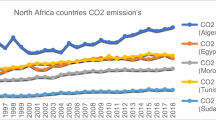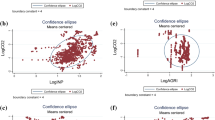Abstract
This study attempts to investigate the environment cleanness between the total factor productivity, natural resources and green taxation on Malaysia’s clean environment. Using the environmental Kuznets curve (EKC) hypothesis, this study employs the bootstrap quantile estimates based on the annual data series covering the period of 1970–2018 to analyse the quantile effect factors affecting environment cleanness in Malaysia. The empirical estimates of this study reject the EKC hypothesis throughout the quantile levels, while the green taxation shows a negative sign which indicated government fiscal policies are reducing carbon emission in the upper quantiles. There is also homogeneity slope equality effect between total factor of productivity and green taxation on carbon emissions in the middle and upper quantile levels, while natural resources are indication heterogeneity effect on all quantile levels. From the policy point of view, if Malaysia wants to get environment cleanness, there is a need for comprehensive policies of total factor of productivity with environment innovation-friendly and technological improvement in all major economic sectors of the country.

Similar content being viewed by others
References
Ahmed K, Shahbaz M, Qasim A, Long W (2015) The linkages between deforestation, energy and growth for environmental degradation in Pakistan. Ecol Indic 49:95–103
Ali W, Abdullah A, Azam M (2006) The dynamic linkage between technological innovation and carbon dioxide emissions in Malaysia: an autoregressive distributed lagged bound approach. Int J Energy Econ Policy 6(3):389–400
Amri F (2018) Carbon dioxide emissions, total factor productivity, ICT, trade, financial development, and energy consumption: testing environmental Kuznets curve hypothesis for Tunisia. Environ Sci Pollut Res 25:33691–33701
Amri F, Zaied YB, Lahouel NB (2019) ICT, total factor of productivity, and carbon dioxide emissions in Tunisia. Technol Forecast Soc Change 146:212–217
Antonakakis N, Chatziantoniou I, Filis G (2017) Energy consumption, CO2 emissions, and economic growth: an ethical dilemma. Renew Sust Energ Rev 68(1):808–824
Barış-Tüzemen Ö, Tüzemen S, Çelik AK (2020) Does an N-shaped association exist between pollution and ICT in Turkey? ARDL and quantile regression approaches Environ Sci Pollut Res 27:20786–20799
Barragán-Beaud C, Pizarro-Alonso A, Xylia M, Syri S, Silveira S (2018) Carbon tax or emissions trading? An analysis of economic and political feasibility of policy mechanisms for greenhouse gas emissions reduction in the Mexican power sector. Energy Policy 122:287–299
Begum RA, Sohag K, Abdullah SMS, Jaafar M (2015) CO2 emissions, energy consumption, economic and population growth in Malaysia. Renew Sust Energ Rev 41:594–601
Berry MA (2008) Cleaning and the environment. Cleaning Industry Research Institute (CIRI). https://www.ciriscience.org/. Accessed 26 Jan 2020
Carattini S, Carvalho M, Fankhauser S (2018) Overcoming public resistance to carbon taxes. WIREs Climate Change 9(5):e531
Caviglia-Harris JL, Chambers D, Kahn JR (2009) Taking the “U” out of Kuznets: a comprehensive analysis of the EKC and environmental degradation. Ecol Econ 68:1149–1159
Chen R, Deng L (2018) What is role of different type of pollution in TFP growth? Empirical research in China. Chem Eng Trans 67:319–324
Danish Baloch MA, Mahmood N, Zhang J (2019) Effect of natural resources, renewable energy and economic development on CO2 emissions in BRICS countries. Sci Total Environ 678:632–638
Dickey DA, Fuller WA (1981) Likelihood ratio statistics for autoregressive time series with a unit root. Econometrica 49(4):1057–1072
Dogan E, Seker F (2016) Determinants of CO2 emissions in the European Union: the role of renewable and non-renewable energy. Renew Energy 94:429–439
Dogan E, Turkekul B (2016) CO2 emissions, real output, energy consumption, trade, urbanization and financial development: testing the EKC hypothesis for the USA. Environ Sci Pollut Res 23(2):1203–1213
Dogan E, Tzeremes P, Altinoz B (2020) Revisiting the nexus among carbon emissions, energy consumption and total factor of productivity in African countries: new evidence from nonparametric quantile causality approach. Heliyon 6(3):e03566
Engle RF, Granger CW (1987) Cointegration and error correction: representation, estimation, and testing. Econometrica 55(2):251–276
Farabi A, Abdullah A, Setianto RH (2019) Energy consumption, carbon emissions and economic growth in Indonesia and Malaysia. Int J Energy Econ Policy 9(3):338–345
Fei Q, Rasiah R, Shen LJ (2014) The clean energy-growth nexus with CO2 emissions and technological innovation in Norway and New Zealand. Energy Environ 25(8):1323–1344
Filipović S, Golušin M (2015) Environmental taxation policy in the EU-new methodology approach. J Clean Prod 88:308–317
Freire-González J, Puig-Ventosa I (2019) Reformulating taxes for an energy transition. Energy Econ 78:312–323
Friedl B, Getzner M (2003) Determinants of CO2 emissions in a small open economy. Ecol Econ 45:133–148
Gregory AW, Hansen BE (1996) Residual-based tests for cointegration in models with regime shifts. J Econ 70(1):99–126
Gupta M (2016) Willingness to pay for carbon tax: a study of Indian road passenger transport. Transp Policy 45:46–54
Hann J (1995) Bootstrapping quantile regression estimators. Economet Theor 11:105–121
Hassan ST, Xia E, Huang J, Khan NH, Iqbal K (2019) Natural resources, globalization, and economic growth: evidence from Pakistan. Environ Sci Pollut Res 26:15527–15534
He P, Ya Q, Chengfeng L, Yuan Y, Xiao C (2019) Nexus between environmental tax, economic growth, energy consumption, and carbon dioxide emissions: evidence from china, Finland, and Malaysia based on a Panel-ARDL approach. Emerging Markets Finance and Trade https://doi.org/10.1080/1540496X.2019.1658068
Holtz-Eakin D, Selden TM (1995) Stoking the fires? CO2 emissions and economic growth. J Public Econ 57:85–101
Johansen S (1995) Likelihood-based inference in cointegrated vector autoregressive models. Oxford University Press, New York
Johansen S (1991) Estimation and hypothesis testing of cointegration vectors in Gaussian vector autoregressive models. Econometrica 59(6):1551–1580
Kalaitzidakis P, Mamuneas TF, Stengos T (2018) Greehouse emissions and productivity growth. J Risk and Financial Manag 11(38). https://doi.org/10.3390/jrfm11030038
Khan SAR, Jian C, Zhang Y, Golpîra H, Sharif A (2019) Environmental, social and economic growth indicators spur logistics performance: from the perspective of South Asian Association for Regional Cooperation Countries. J Clean Prod 214:1011–1023
Koenker R, Bassett G (1978) Regression quantiles. Econometrica 46(1):33–50
Koenker R, Bassett G (1982) Tests of linear hypotheses and l″ 1 estimation. Econometrica 50(6):1577–1583
Koenker R, Xiao Z (2004) Unit root quantile autoregression inference. J Am Stat Assoc 99(467):775–787
Le DN (2019) Environmental degradation and economic growth in ASEAN-10: the perspective of EKC hypothesis. Malays J Econ Stud 56(1):43–62
Lin B, Li X (2011) The effect of carbon tax on per capita CO2 emissions. Energy Policy 39:5137–5146
Lin B, Nelson BI (2019) Determinants of industrial carbon dioxide emissions growth in Shanghai: and quantile analysis. J Clean Prod 217:776–786
Liu H, Chen Z, Wang J, Fan J (2017) The impact of resource tax reform on China’s coal industry. Energy Econ 61:52–61
Liu SF, Ren HY, Niu Y (2014) Discussion on development trend in the construction industry-green low carbon buildings. Appl Mech Mater 641-642:1021–1024
Loganathan N, Shahbaz M, Taha R (2014) The link between green taxation and economic growth on CO2 emissions: fresh evidence from Malaysia. Renew Sust Energ Rev 38:1083–1091
Long X, Sun M, Cheng F, Zhang J (2017) Convergence analysis of eco-efficiency of China’s cement manufacturers throught unit root test of panel. Energy 134:709–717
Long X, Kin A, Dai Y (2019) FDI and convergence analysis of productivity across Chinese prefecture-level cities through bootstrap truncation regression. Singap Econ Rev:1–17. https://doi.org/10.1142/S0217590819500425
Luo Y, Long X, Wu C, Zhang J (2017) Decoupling CO2 emissions from economic growth in agricultural sector across 30 Chinese provinces from 1997 to 2014. J Clean Prod 159:220–228
MacKinnon, J (1991) Critical values for cointegration tests. In: Engle R, Granger C (ed) Long run economic relationships. Oxford University Press, New York, pp 267–276
Martínez-Zarzoso I, Bengochea-Morancho A (2004) Pooled mean group estimation of an environmental Kuznets curve for CO2. Econ Lett 82(1):121–126
Mills JH, Waite TA (2009) Economic prosperity, biodiversity conservation, and the environmental Kuznets curve. Ecol Econ 68(7):2087–2095
Moutinho V, Madaleno M, Inglesi-Lotz R, Dogan E (2018) Factors affecting CO2 emissions in top countries on renewable energies: a LMDI decomposition application. Renew Sust Energ Rev 90:605–622
OECD Economic Surveys (2019) Malaysia July 2019 overview. http://www.oecd.org/economy/surveys/Malaysia-2019-OECD-economic-survey-overview.pdf
Phillips PCB, Perron P (1988) Testing for unit roots in time series regression. Biometrika 75(2):335–346
Rafindadi AA (2016) Does the need for economic growth influence energy consumption and CO2 emissions in Nigeria? Evidence from the innovation accounting test. Renew Sust Energ Rev 62:1209–1225
Rahman MS, Noman AHM, Shahari F (2017) Does economic growth in Malaysia depend on disaggregate energy? Renew Sust Energ Rev 78:640–647
Riti JS, Song D, Shu Y, Kamah M (2017) Decoupling CO2 emission and economic growth in China: is there consistency in estimation results in analyzing environmental Kuznets curve? J Clean Prod 166:1448–1461
Rodríguez M, Robaina M, Teotónio C (2019) Sectoral effects of a green tax reform in Portugal. Renew Sust Energ Rev 104:408–418
Saboori B, Sulaiman J, Mohd S (2012) Economic growth and CO2 emissions in Malaysia: a cointegration analysis of the environmental Kuznets curve. Energy Policy 51:184–191
Saidi K, Hammami S (2015) The impact of energy consumption and CO2 emissions on economic growth: fresh evidence from dynamic simultaneous-equations models. Sustain Cities Soc 1:62–70
Salman M, Long X, Dauda L, Mensah CN, Muhammad S (2019) Different impacts of export and import on carbon emissions across 7 AEAN countries: a panel quantile regression approach. Sci Total Environ 686:1019–1029
Shahbaz M, Sinha A (2018) Environmental Kuznets curve for CO2 emissions: a literature survey. J Econ Stud 46(1):106–168
Shapiro SS, Francia RS (1972) An approximate analysis of variance test for normality. J Am Stat Assoc 67:215–216
Shapiro SS, Wilk MB (1965) An analysis of variance test for normality (complete samples). Biometrika 52:591–611
Stern DI (2003) International society for ecological economics. Internet Encyclopaedia of Ecological Economics. The Environmental Kuznets Curve. Department of Economics, Rensselaer Polytechnic Institute, Troy
The Conference Board (2019) Total economy database. The Conference Board, New York
Wajahat A, Abdullah A, Azam M (2016) The dynamic linkage between technological innovation and carbon dioxide emissions in Malaysia: an autoregressive distributed lagged bound approach. Int J Energy Econ Policy 6(3):389–400
World Bank (2019) World development indicators. World Bank Group, Washington
Wu Y, Chau KW, Lu W, Shen L, Chen J (2018) Decoupling relationship between economic output and carbon emission in the Chinese construction industry. Environ Impact Assess Rev 71:60–69
Yenipazarli A (2019) Incentives for environmental research and development: consumer preferences, competitive pressure and emissions taxation. Eur J Oper Res 276(2):757–769
Yunyan L (2019) Research on the development trend of renewable energy in low carbon environment. J Appl Sci Eng Innov 6(1):31–35
Zhang J, Zhang Y (2018) Carbon tax, tourism CO2 emissions and economic welfare. Ann Tour Res 69(C):18–30
Zheng H, Hu J, Wang S, Wang H (2019) Examining the influencing factors of CO2 emissions at city level via panel quantile regression: evidence from 102 Chinese cities. Appl Econ 51(35):3906–3919
Zivot E, Andrews DWK (2002) Further evidence on the great crash, the oil-price shock, and the unit-root hypothesis. J Bus Econ Stat 10(3):251–270
Funding
This research work was supported by the Fundamental Research Grant Scheme (FRGS) funded by The Ministry of Education Malaysia (FRGS/1/2017/SS08/UTM/02/5).
Author information
Authors and Affiliations
Corresponding author
Additional information
Responsible Editor: Eyup Dogan
Publisher’s note
Springer Nature remains neutral with regard to jurisdictional claims in published maps and institutional affiliations.
Rights and permissions
About this article
Cite this article
Loganathan, N., Mursitama, T.N., Pillai, L.L.K. et al. The effects of total factor of productivity, natural resources and green taxation on CO2 emissions in Malaysia. Environ Sci Pollut Res 27, 45121–45132 (2020). https://doi.org/10.1007/s11356-020-10291-4
Received:
Accepted:
Published:
Issue Date:
DOI: https://doi.org/10.1007/s11356-020-10291-4




